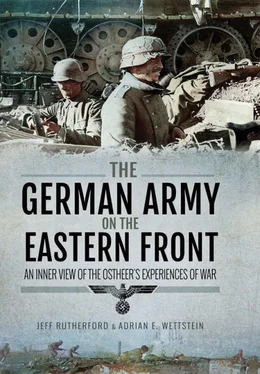If at all possible, the breakthrough of enemy positions must be carried out in a complete corps’ attack as follows: first the entire artillery helps all tanks and assault guns of one division through, then the entire artillery shells the second divisional [attack] sector until it is ripe for attack, and the tanks that initially went on with the attack of the first division, break out of the second divisional [attack] sector from the flank or the rear. That procedure is particularly necessary due to the decreasing number of panzers during the course of a combat action. In defence, the armoured groups of the divisions have to be held in reserve and are to be centrally commanded by the corps. Their cooperation with the air force is to be secured.
The strongly decreasing number of tanks, assault guns and self-propelled guns are partly the consequence of the unsuitable deployment of workshop companies and maintenance services. In particular, army troops position themselves so clumsily, that 100% of their repairs break down on the long march to the front. In this way, many units were worn down without combat. Commander training courses must be expanded on in that area. Firm leadership and constant supervision of workshop and maintenance services through the corps and divisions is today more important than ever.
In its present organization, the artillery is very difficult to move, especially because the apparatus of staffs and supply units, which is constructed around the few barrels, is too extensive and complicated. In this way, a battalion staff, which today often commands no more than nine barrels, can just as well cope with three times that number. To achieve a mass effect and a destructive effect at the decisive point, an increase of mortars and [rocket] launchers at the expense of the [barrel] artillery is necessary. The Russian has moved in this direction for more than a year.
Since 1941, Soviet defences had become deeper and more stable, as well as better organized and led. This demanded a more thoroughly planned German breakthrough with heavy fire support as described above. The Red Army, recognizing that the Germans favoured flank attacks, strengthened these areas, forcing the Germans to look for new attack methods. German units also practised more night attacks in the second half of the war, as these allowed for surprise. Fire support and fire preparation became important parts of armoured attacks, issues that rarely surfaced in 1941 and 1942 attacks.
Whatever the value of armoured units in the German army, they were a distinct minority. The report shows that the mass of the army – infantry divisions – could no longer effectively fight, unless heavily reinforced by assault guns or tank hunters and infantry anti-tank weapons, and by becoming more mobile. The points concerning the infantry division in the report are part of a far larger discussion, arising from mid-1943 on, as the German military leadership recognized the decreasing combat power of their infantry units, terming it an ‘infantry crisis’. In addition to the lack of mobility and anti-tank capabilities, this decrease was also the consequence of manpower shortages leading to exhaustion in the troops and thereby a diminishing of the will to resist. The infantry crisis was never properly solved, as the melting resources of the Third Reich did not allow for such a far-reaching transformation.
Chapter 4
Supplying the German Eastern Army
As seen in chapters 1and 3, combat on the Eastern front involved an unprecedented level of men and material and reached a hitherto unheard of level of intensity. This was only possible when the German (and Soviet) armies could rely on a large network of rear units and received a continuous stream of supply goods. [1]Rear units performed numerous tasks to maintain the frontline troops’ combat efficiency, including transporting men, as well as material and supply goods, the maintenance and repair of weapons and equipment, collecting food and preparing meals, and caring for horses. Other vital tasks included building, maintaining and securing lines of communications and necessary infrastructure such as depots, quarters, railway lines, streets, bridges and airports, and medical care for wounded as well as the prevention of illness. Finally numerous administrative tasks, such as promotions and awards, the ordering of goods and replacements, the regulation of leave, military justice, sending soldiers to training courses, and so on, also had to be completed.
The stream of goods needed by the German armies included most obviously ammunition, fuel and food. But there were many more, often forgotten goods: an army literally marching by foot deep into Soviet territory required shoes and replacement clothes. In addition to essential food rations, it was important for the morale of the troops to provide them with alcohol, tobacco and candies. Extra efforts could be achieved by using methamphetamines such as the widely distributed Pervitin. Articles of daily use such as toothbrushes, razor blades and soap also had to be supplied. All kinds of individual equipment had to be replaced due to wear or loss, such as helmets, pouches, spades and so on. The same was true for weapons, ranging from bayonets and hand guns to tanks, aircraft and guns. Larger non-combat equipment such as field kitchens, vehicles, radio sets and generators were much needed, as were consumable materials and equipment for special units, such as engineers and medical services. Wired communications, still essential for the German army, necessitated kilometres of cable and electrical tape, not to mention all the special equipment required to lay the wire. To keep all of these complex army systems working, many materials for their maintenance were needed, such as a broad array of lubricants. In case of breakdown, workshop units with many different tools and machines – that also needed replacement equipment – repaired those systems, but they obviously needed spare parts in huge quantities. And due to the lack of production and standardization, there were thousands of different spare parts in the supply system. This problem was significantly increased by the use of captured equipment, primarily motor vehicles, but also weapons. Army Group Centre estimated at the end of 1941 that its sub-units were in need of over a million different spare parts. The massive use of horses also made fodder an extremely important commodity. Specialists responsible for ensuring that the horses remained healthy enough to work, such as blacksmiths and veterinarians, also needed many specific items. Harsh winter conditions demanded their own goods such as winter clothes, trench ovens and Hindenburg lights for the men and antifreeze agents and cold-resistant spare parts for guns and vehicles. Marching into climatically different areas also added demands, such as special medicaments and vaccines for the Germans who entered the Kuban area, a subtropical region. Other areas such as the relatively tree-less steppe west of Stalingrad required the supply of wood for the construction of defensive positions or shelters, the maintenance of streets and railroads or simply just for heating material. And finally, to keep this supply system working, many typewriters and phones, as well as a tremendous amount of paper, were necessary too.
The following source gives a rough overview of the different tasks demanded of a division’s rear troops, as well as some numbers to consider, such as the distances to cover or the amount of material to be transported. It also shows once again the strain caused by prolonged heavy combat, such as urban warfare, on supplying troops. The source is a report on the achievements of the 7th Infantry Division’s supply services during the one-week battle for Mogilev in July 1941: [2]
The fight for the enemy bridgehead at Mogilev brought increased burdens on all supply troops and, in part, lasting activity day and night. […]
Читать дальше






![John Stieber - Against the Odds - Survival on the Russian Front 1944-1945 [2nd Edition]](/books/405234/john-stieber-against-the-odds-survival-on-the-russian-front-1944-1945-2nd-edition-thumb.webp)





